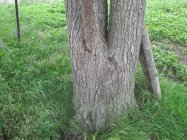We're in the process of converting some pasture into tillable acres. This is going to have to come down.
Anyone here attempted this? Is this tree usable? Age is unknown and it has been growing in fairly damp soil. Quality may not be the best, but the idea did seem to please my retiring stepfather. I wouldn't mind having a few stocks made from a tree from the family farm. We have a backhoe coming to do some other work, so no problems digging it up. I would guess it's 30 inches across at the trunk.
Anyone here been there and done that?
-

skid 004.JPG
75 KB
· Views: 293
I tried it 30 years ago, in Illinois soil, same situation, family farm, over 100 year old tree. Waste of time and effort for me, open grained, no figure, soft. You may have better luck, give it a try, what is there to loose.
Try the root wad. Was the dirt off best you can and go from there up.
The root ball, and the area where the crotch is, is going to be as good as it will get.
Wet soil is not the best for slow growth.....
Quarter saw it and coat the ends with wax, and set it in a attic for as many years as it take to pull it down to 6-8 % moisture..
How far up from ground level should I cut this? Obviously I need to keep the crotch.
I understand this is like doing surgery over the internet, but I've never attempted this and my searches aren't turning up much. Help is greatly appreciated.
Since it is going to be cut down anyway.............recommend that you first cut square with a chainsaw each part of the two separate trunks about 1 foot above the "V" notch. After you have dropped these two, examine the cut ends for the amount of heartwood diameter exposed, and carefully note the growth rings, the finer they are the better. This presents you with a decision point as to whether you want to pursue rifle stock(s) or firewood above the "V" notch!! If you have more or less 8-10 inches in diameter of heartwood showing (doubtful), next cut off a 4-foot mini-log and examine the amount of heartwood diameter at that smaller end...and so on until there does not appear to be enough heartwood to fashion the butt stock area and fore arm rise of a rifle stock?
For your "V" notched stump, dig it out with the backhoe. Clean it up so that you don't mind using your chain saw on it to trim away the roots!? Kind of trim the roots off to match the diameter of the trunk exposed above ground. Take it back to the barn, and really clean the underground portion up. Locate a good "band saw" mill operation. Carry your trunk to the mill. From your picture, I can't tell you what you've got? Since the most valuable part of a lower walnut trunk like you have just cut up is the under ground portion (for veneer), first ask the mill operator, "How much is it worth?
Then, if you still want to pursue rifle stock(s), ask his advise in cutting it up? I would want to be present for that cutting, and put in my 2 cents worth (since I majored in Forestry in college). I would be inclined to first have him exploratory cut straight down the "V" to produce equal sides. Next, rotate one of the halves to "flat side down" on the carriage, and start cutting 4-inch wide planks...same for the other half. And, if you have not abandoned the "4-foot mini-logs" from atop the "V"; start cutting 4-inch wide planks.
Assuming that you've really got some GOOD rough-cut wood here...and the mill operator thinks so too; it's time to think about "drying" the wood. The cheapest method is to air-dry at your place...someone mentioned in the attic. If you have "hay barn" space with concrete floor, that's great! Your garage, covered back porch, etc. Mind you now, for uncontrolled "air-drying", we are looking at 15 to 20 years. Hopefully you will have a level concrete floor. "Level" is key here, if you want to have nice straight 3 and 1/2 thick planks (shrunk, didn't they) in 20 years, you must start stacking your planks from a "level foundation". Proceed to Home Depot and purchase some of their finished red oak...we want to use this to make what is called "stickers" to separate the stacked planks to allow air circulation. For your 4-foot planks, I'd recommend (5) 2-inch wide stickers crosswise under each plank, starting on the concrete, with stickers directly under each other as they proceed up the stack. I don't know how high we are getting here!!? So, maybe you might need 2 side by side stacks? Cap each stack with your worst plank, and put your old 250 pounds of bar bell weights across the top to keep them straight. As someone mentioned wax the ends...I've used the black tar that horticulturist paste over cut tree limbs to protect the wound...to forestall checking and splitting on the ends.
Just sit back and wait. The worst think that can happen is that you might just have some well dried fire wood down the way! I did it with a 32-inch diameter small end, wild cherry 12-foot butt log about 19 years ago! Haven't come up with a single stock yet, a lot of other things like fireplace mantels...but it just cost me $60 bucks to have it band sawed up.
Good luck!
Dan
Exactly what he said^^^^^^^^^ But you can have it kiln dried and save some time.
LitLBoy
Some of the most beautiful walnut I've taken has come from 1'-2' below current ground level .
Talk to a professional stock maker and a profession woodworker. Since you didn't sound as though it would be you making the stock, try to sell the entire tree to a person experienced and skilled in woodworking with the provision you get a stock from the wood from the old tree.
Uthink Uknow said:
Talk to a professional stock maker and a profession woodworker. Since you didn't sound as though it would be you making the stock, try to sell the entire tree to a person experienced and skilled in woodworking with the provision you get a stock from the wood from the old tree.
I'm going to do the majority of the work myself, assuming there's wood worth using in there. Time will tell.
Thanks for the suggestions.
You don't have to do the stock from one piece. Here is a post with a picture of a stock I did from a cherry tree I cut in the early 90's.
http://forum.accurateshooter.com/index.php?topic=3811066.msg36203452#msg36203452
The wood was cut into 1" boards and air dried for 20 years, albeit it was just standing on end in the garage. I planed the boards and glued five pieces together to get the blank for the stock. A friend of mine made it on his CNC mill and it has had problems with minor splitting at the fore-end joints. My friend said it was a combination of the poor quality glue I used along with the wood not being as dry as it needed to be. If 20 years won't dry 1" boards, I'd hate to take a chance on 4" thick ones.
The best bet is to use 1" boards and glue them up with good glue, but have them kiln dried if you want to do it in your lifetime.
I may end up going the laminate route. I'll have to see what's there. 30 inches across isn't very big.
Finding someone to process the stump and root ball could be a bit of a pain. Sawmills aren't common here on the MN prairie. I'm hoping the person I get to cut it will be able to refer me to someone with a kiln.
You could always sell the tree to a logger and use the funds elsewhere if you back down on the project. I know the route you want to go has more of a meaning behind it but the funds received might be helpful in the purchase of a stock. Personally I say have at it and see what you get. Worst case scenario you keep warm for a little in the winter ;D
Pasture trees usually have barb wire, nails or some other metal in them. Some mills don't want them. Bring extra chains. ;D
-

Bike in a tree.JPG
97.1 KB
· Views: 120
somebody must live under water for wood to get to 8% taking 20 years.
air dried wood here (western colorado) will get to 8% if left OUTSIDE in a few months. at least if it is summer. standing trees here are under 25% from green in two years or less.
stickers do not need to be fancy, just the same thickness and made out of something that will not stain the wood. i would use the edgings from the walnut tree you just cut up.
Cut it, immediately dip the end grain in Anchorseal, sticker it and dry it ... SLOWLY at first (not in an attic). One year per inch thickness should get it to where you want it. Good luck.
I would run a metal detector over it before you cut it as it will usually have nails in it and will leave a blue like streak through the grains. What type of tree is this ? Kiln drying would be your best bet for quicker straighter wood slabs that are ready to be used and lesser moisture content so you don't have shrinkage on your finished project. Most guys with a portable band mill would be able to cut it correctly.The guy that's sawing your wood might have the wax coating for the ends of your wood to coat.
spencerhenry said:
somebody must live under water for wood to get to 8% taking 20 years.
air dried wood here (western colorado) will get to 8% if left OUTSIDE in a few months. at least if it is summer. standing trees here are under 25% from green in two years or less.
stickers do not need to be fancy, just the same thickness and made out of something that will not stain the wood. i would use the edgings from the walnut tree you just cut up.
Moisture content is important, but the age of the blank is just as important. It's known as "curing". "Curing" and "drying" are not the same thing.
Finally got this thing out of the ground a few days ago. Cut it off 14 to 16 inches above the crotch to find 10 to 11inches of heartwood in each side. Pleasantly surprised with the color of it, though I'm certainly no expert. Nice Dark browns and yellows when I wetted the saw cut. Counted roughly 50 rings in the heartwood on one of the limbs.
Digging the huge wad of clay out of the roots so I could get it up to the yard with the skid steer was an "interesting" experience.....
I'll update next spring when I get it cleaned up, trimmed, and find someone to mill it. If nothing else, I should be able to get a few laminates out of it.
Find the phone number for Ceicil Fredi in Las Vegas, NV. He is one of the best gun stock suppliers in the United States. He will advise you of what you need to do. Ceicil Fredi Gun Stocks, he has 1000's of stocks and is always traveling to find good wood.












